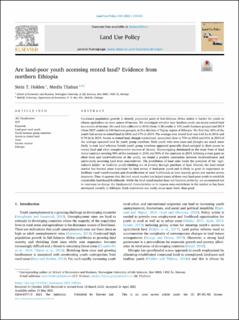| dc.description.abstract | Continued population growth in densely populated parts of Sub-Saharan Africa makes it harder for youth to choose agriculture as main source of income. We investigate whether near landless youth can access rented land as a source of income. We used data collected in 2016 (from 1138 youths in 119 youth business groups) and 2019 (from 2427 youths in 246 business groups), in five districts of Tigray region of Ethiopia. We find that 42% of the youth had access to rented land in 2016 and 47% in 2019. The average area rented land was 0.66 ha in 2016 and 0.74 ha in 2019. Access to rented land, though constrained, accounted close to 70% in 2016 and 61% in 2019 of the average operated land by youth group members. Male youth who own oxen and ploughs are much more likely to rent land whereas female youth group members appeared generally disadvantaged in their access to rented land and other complementary sources of income. Sharecropping dominated as the main from of land rental contract covering 94% of the contracts in 2016 and 90% of the contracts in 2019. Utilizing a trust game to elicit trust and trustworthiness of the youth, we found a positive association between trustworthiness and particularly accessing land from non-relatives. The prohibition of land sales limits the potential of the “agricultural ladder” to facilitate youth climbing out of poverty through purchase of land. Overall, the land rental market has become more important for land access of land-poor youth and is likely to grow in importance to facilitate rural transformation and diversification of rural livelihoods as land scarcity grows and market access improves. Thus, it appears that the land rental market has helped many of these very land-poor youth to establish sustainable land-based livelihoods. While the land rental market does not function perfectly, we recommend not to intervene to change the fundamental characteristics or to impose area restrictions in the market as has been attempted recently in Ethiopia. Such restrictions can easily cause more harm than good. | |
